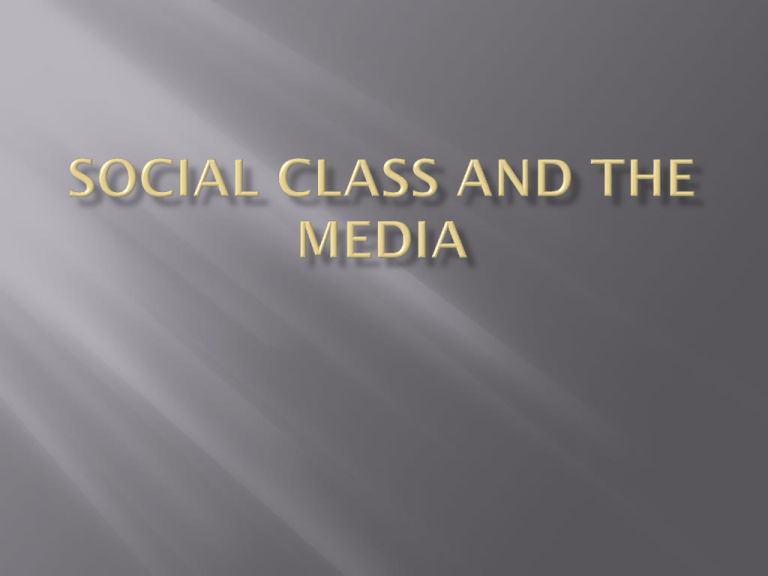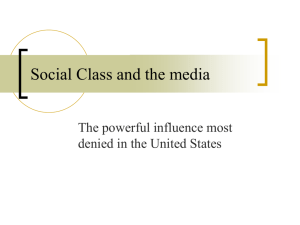Social_Class
advertisement

All societies have been arranged hierarchically The U.S. is no exception More uneven in wealth distribution than most industrialized capitalist societies, but not as much so as developing nations Historical trend toward less economic stratification was reversed beginning in the 1980s Source: Thomas Piketty and Emmanuel Saez, "Income Inequality in the United States, 1913-1998," Quarterly Journal of Economics, 118(1), 2003. Updated to 2005 at http://emlab.berkeley.edu/users/saez . Based on U.S. Census Data Social class includes more than income or place within the economic system Education Taste/culture Manners (breeding) Religion Preferences Race and gender Residence Largely denied by U.S. culture “Classless society” “The belief that the United States is a classless society or, alternatively, that most Americans are “middle class” persists . . . despite pervasive socioeconomic stratification” (Bullock, Wyche and Williams, 2001) “ It is impossible to understand people's behavior...without the concept of social stratification, because class position has a pervasive influence on almost everything...the clothes we wear...the television shows we watch...the colors we paint our homes in and the names we give our pets... Our position in the social hierarchy affects our health, happiness, and even how long we will live. ” William Thompson, Joseph Hickey, Society in Focus, 2005 Two flavors: Analysis of news, documentary, political pundits, etc. in non-fictional content areas Looking for bias, falsehoods, etc. Analysis of entertainment media Looking for ideological, mythical presentations of the world Portrayals of characters who represent a given class Do the behaviors/attitudes of the character ‘explain’ a position of subordination or superordination? Do plots, settings, etc. indicate system openness or structure? Stereotypes are ‘ideal’ characterizations of a member of some identified group Though often based in some ‘reality’ they are often exaggerated and may be distorted (often in a negative fashion) Although we are used to thinking of stereotypes in terms of race and gender, stereotypes exist for all ‘groups’ including class Blue Collar Hillbilly Redneck White trash They can blind observers to the individual variation among members of the ‘group’ False and potentially demeaning expectations when interacting with individuals They impact intergroup interactions and even may become self-fulfilling They justify social inequality of treatment and/or public policy that relates to groups Blaming the victim Upper class Middle class/ Upper middle class Working class Lower class Amount of Above representation population levels Above population levels Below population levels Below population levels News Professionals, expertise in science, medicine Industrial conflict, crime Crime Business interests, commentary Entertainment Powerful criminals, Lifestyles, reality Lawyer shows, Cops, reality family dramas, TV, sitcoms sitcoms, medical shows Criminals, Daytime talk “The prototypical working-class male is incompetent and ineffectual, often a buffoon, wellintentioned but dumb. In almost all working-class series, the male is flawed, some more than others . . . . He fails in his role as a father and husband, is lovable but not respected.” •Butsch, Social Class and Television in Encyclopedia of Television Violent Brutish Prone to hair-brained schemes to get ahead Unintelligent Focused on cars, sports, sex Racist/Xenophobic Politically right-wing Sexist Lacking in taste and sophistication Noble Loyal Self-sacrificing Strong-willed ABC’s The Middle Working-class wives are depicted “as exceeding the bounds of their feminine status, being more intelligent, rational, and sensible than their husbands. . . . Working-class men are de-masculinized by depicting them as child-like; their wives act as mothers. . . . These results indicate the importance of accounting for class along with gender.” • Butsch, Social Class and Television in Encyclopedia of Television Working-class singles tend to be oversexed, loud and lacking in tact or sophistication They exhibit extreme gender-role emphasis as goodol’-boys or redneck women, etc. The Waltons Police shows (cops on the beat v. detectives/specialists) The Deadliest Catch CEO switch thing Less contested and ambiguous than are bluecollar representations Mostly represented as extremely flawed Violent Criminal Drug-taking Unintelligent Sleazy Trashy Oversexed Unsophisticated Domestic Kids Dependant/“Golddigger” Focused on men Content analyses show a great overrepresentation of African Americans in depictions of the poor Gilens (1996) content analysis of three major news magazines found African Americans were represented in 62% of stories about poverty though they comprised 29% of poor (no more info available) Asian Americans, stereotyped as hard working and conscientious, rarely show up in stories about the poor European Americans greatly overestimate the percentage of African Americans who are poor European Americans greatly overestimate the percentage of African Americans who are poor African American men—members of “threatening and violent underclass” African American women—welfare queens or as “ignorant, promiscuous women caught in a self-perpetuating ‘cycle of dependency’” Emphasis on African Americans tends to render white poor ‘invisible’ in popular culture “Although the ‘typical’ drug consumer and dealer is an employed, high-school-educated European American man, the majority of arrests depicted on reality-based crime programs involve African American and Latino men in densely populated, urban areas (Anderson, 1994).” April-July 1999 newspapers 412 articles 24% contained at least some overt discussion of race/ethnicity African American articles: 8 focused on chronic poverty and single motherhood 5 focused on fraud 6 highlighted the lives of African Americans who had triumphed over poverty 60% of articles took balanced/neutral tone 32% positive (supported services and programs for the poor) 8% negative (fraud, drug addiction, etc.) 60% portrayed poor as deserving of support (hard-working families with children in need) 17% portrayed poor negatively (drug users, neglectful parents) 14% neutral 8% mixed Presenting the interests of the well-off (e.g., stock, financial portfolios, and leisure time) as universal concerns Downplaying the structural economic concerns (e.g., job security, income) of the working class and poor Emphasizing shared interclass concerns (e.g., safety, crime) Portraying the middle class as the norm, with little representation of interclass tension Imply, if not openly claim, that biological/genetic ‘causes’ of depicted inferiority explain social inequity Are painful for those they supposedly pertain to Justify harsh social policy, police action as the only reasonable response to socially objectionable behaviors Blaming the victim Maintenance of an uneven social reward system Those who receive less of the system’s output deserve their fate because they have personality flaws or don’t try hard enough Rewards not fairly tied to performance Low self-esteem among ‘lower classes’ Exultation of self-interest Mean World (for real) Tabloid news shows tended to “focus on stories involving upper-class criminals, particularly celebrities, whereas “highbrow” news programs were more likely to focus on stories involving working-class, unemployed criminals.” Also tend to show “rags to riches” stories or the “hollowness of wealth” “Welfare recipients are among the . . . the most hated and stereotyped groups in contemporary society” Only one among 17 stereotyped groups (feminists, housewives, retarded people, Blacks, migrant workers, etc.) that respondents both disliked and disrespected. Lacking both competence and warmth However, most common group of welfare recipients is poor children Media representations concentrate on their mothers Those who are well off and those who are not accept many of the same assumptions and explanations for their economic lot Thus, the have-nots act to discipline themselves rather than making demands of the system Workers who accept their role do not present as much a threat in the mines and factories






